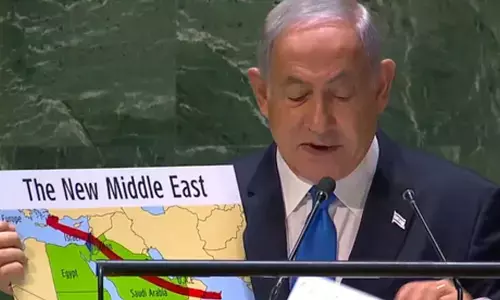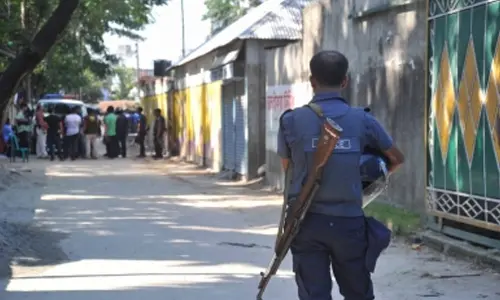Electronic evidence in court

Electronic evidence in court. Now the evidence is either recorded on cell phones or CCTV cameras. Cyber records provide accuracy of time and content. The call data records are catching criminals.
.jpg) Now the evidence is either recorded on cell phones or CCTV cameras. Cyber records provide accuracy of time and content. The call data records are catching criminals. It is difficult to escape the strict proof of crime. Rapists are getting caught with their mobile recording of the incident, which they wanted to use for blackmailing the victim into silence. Complicated investigation can now hope to turn into clinching piece of criminality. The investigators and the trial should turn more electronic, forensic and scientific to nail the criminals.
Now the evidence is either recorded on cell phones or CCTV cameras. Cyber records provide accuracy of time and content. The call data records are catching criminals. It is difficult to escape the strict proof of crime. Rapists are getting caught with their mobile recording of the incident, which they wanted to use for blackmailing the victim into silence. Complicated investigation can now hope to turn into clinching piece of criminality. The investigators and the trial should turn more electronic, forensic and scientific to nail the criminals.
‘Information’ includes electronic information and documents include the electronic documents for the purposes of evidence. This change was affected by the technology revolution and the Information Technology Act, 2000, to accommodate it. Traditional concept of evidence is totally reformed. Sections 2(r) and 2(t) of the IT Act defines ‘information’ in electronic form as information generated, sent, received or stored in media, magnetic, optical, computer memory, micro film, computer generated micro fiche or similar device.
Section 92 of this Act read with Schedule 2 amends the definition of ‘evidence’ in Section 3 of the Evidence Act. In 1967 itself the Supreme Court in Yusufalli case observed that like a photograph of a relevant incident, a contemporaneous tape record of a relevant conversation was a relevant fact admissible under Sections 7 & 8 of the Act. The imprint on the magnetic tape is the direct effect of the relevant sources. Thus, if a statement is relevant, an accurate tape record of the statement is also relevant and admissible.
In a significant case Ram Singh v. Col. Ram Singh, the Apex Court laid down certain norms for admissibility of tape recorded conversation:
a) the voice of the speaker must be duly identified by the maker of the record or by others who recognize his voice. Where the maker has denied the voice, it will require very strict proof to determine whether or not it was really the voice of the speaker.
b) The accuracy of the tape recorded statement has to be proved by the maker of the record by satisfactory evidence, direct or circumstantial.
c) Every possibility of tampering with or erasure of a part of a tape recorded statement must be ruled out, otherwise it may render the said statement out of context and, therefore, inadmissible.
In fact, in the most recent case of Tukaram S Dighole v Manikrao Shivaji Kokate , the Apex Court has held that though tape records are “documents” as per Section 3, as they are susceptible to tampering which may not be easily detected, standard of proof as to their authenticity and accuracy should be more stringent as compared to other documentary evidence. Court must be satisfied, beyond reasonable doubt, that there has been no tampering.
d) The recorded cassette must be carefully sealed and kept in safe or official custody.
e) The voice of the speaker should be clearly audible and not lost or distorted by other sounds or disturbance.
In Yusufalli Esmail Nagree vs The State of Maharashtra, AIR 1968 SC 147 decided on 19 April, 1967 (Bachawat, R.S., Judge), Yusufalli wanted to give a bribe of Rs 100 (Ten currency notes of Rs 10 each) to a notice clerk Shaik, seeking a favour of not executing a warrant of arrest.
Notice clerk refused to take it and reported it to the anti-corruption bureau, which laid a trap. The notice clerk called Yusufalli to his residence. Yusufalli handed over notes to him. Through a hidden microphone in that room, the conversation was recorded by a radio mechanic in adjoining room where the police officer was also present. Shaik was the only eye witness. Yusufalli was arrested, charge-sheeted and convicted with the eyewitness Shaik’s account and also with the help of tape-recorded conversation between bribe giver and the officer.
The contemporaneous dialogue between Yusufalli and Shaik formed part of ‘res gestae’ and held to be relevant and admissible under Section 8 of Evidence Act. This dialogue was proved by Shaik’s evidence. The tape-recorded dialogue corroborated the testimony of the Shaik. The Special Judge of Greater Bombay convicted him under Section 165-A of Indian Penal Code (bribery) and sentenced.
In Rup Chand v. Mahabir Parshad (A.I.R. 1956 Punj 173), a tape record of a former statement of a witness was admitted in evidence to shake the credit of the witness under s. 155(3) of the Indian Evidence Act. The case was followed in Manindra Nath v. Biswanath Kundu (67 C.W.N. 191.) In S Pratap Singh v. State of Punjab (A.I.R. 1956 Punj. 173), the tape record of a conversation was admitted in evidence to corroborate the evidence of witnesses who had stated that such a conversation had taken place.
In R. V. Maqsud Ali ([1965] 2 All E.R. 464) a tape record of a conversation was admitted in evidence, though the only witness who overheard it was not conversant with the language and could not make out what was said. If a statement is relevant, an accurate tape record of the statement is also relevant and admissible. The time and place and accuracy of the recording must be proved by a competent witness and the voices must be properly identified.
Question was whether the tape-recorded evidence was acceptable. The process of tape recording offers an accurate method of storing and later reproducing sounds. The imprint on the magnetic tape is the direct effect of relevant sounds. Like a photograph of a relevant, incident, contemporaneous tape record of a relevant conversation is a relevant fact and is admissible under Section 7 of the Indian Evidence Act.
The time and place and accuracy of the recording must be proved by a competent witness and the voices must be properly identified. One of the features of magnetic tape recording is the ability to erase and re-use the recording medium. Because of this facility of erasure and re-use, the evidence, must be received with caution. The court must be satisfied beyond reasonable doubt that the record has not been tampered with.














